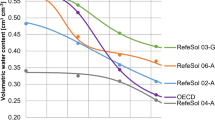Abstract
The effect of the fungicide carbendazim (applied in the formulation Derosal®) on nutrient cycling in soil was determined in Terrestrial Model Ecosystem (TME) tests and corresponding field-validation studies, which were performed in four different countries (United Kingdom, Germany, Portugal, and The Netherlands). The tests used different soil types, and lasted for 16 weeks. On three of the four sites, grassland soils were used while the fourth site had an arable soil. TMEs consisted of intact soil columns (diameter 17.5 cm; length 40 cm) and were taken from the site where the field study was performed. In the first series of TME tests, carbendazim applied at dosages unto 77.8 kg a.i./ha did not affect sulfate and phosphate concentrations in the top 15 cm soil layers. These nutrients were therefore no longer included in the second series of TME tests and the field-validation studies. Ammonium concentrations in the top soil layers of TMEs and field plots, and in the leachates of the TME columns did not show any effect of carbendazim treatment. Nitrate concentrations in soils and leachates did show some reduction at the highest treatment levels (77.8 kg a.i./ha in the first TME tests, 87.5 kg a.i/ha in the second TME tests and the field-validation studies). Since nitrate concentrations in both soils and leachates were correlated with soil moisture content, these effects could however, mainly be attributed to variations in soil moisture contents, and in some cases also indirectly to effects on earthworm activity. It is concluded that carbendazim, even at dosages as high as 87.5 kg a.i./ha, does not have a significant impact on soil nutrient cycling processes. Nutrient levels in TME tests and the field-validation studies generally showed similar patterns, thus confirming the predictive value of the TME test system.
Similar content being viewed by others
References
Cairns, J. (1984). Are single species toxicity tests alone adequate for estimating environmental hazard? Environ. Monit. Assessm. 4, 259-73.
Cheshire, M.V. and Griffiths, B.S. (1989). The influence of earthworms and cranefly larvae on the decomposition of uniformly 14C labelled plant material in soil. J. Soil Sci. 40, 117-24.
Cuppen, J.G.M., Van den Brink, P.J., Camps, E., Uil, K.F. and Brock, T.C.M. (2000). Impact of the fungicide carbendazim on freshwater microcosms. I. Water quality, breakdown of particulate organic matter and responses of macroinvertebrates. Aquat. Toxicol. 48, 233-50.
Edwards, C.A., Knacker, T. and Pokarzhevskii, A. (1998). The prediction of the fate and effects of pesticides in the environment using tiered laboratory soil microcosms. The 1998 Brighton Conference-Pests & Diseases 4C-1, pp. 267-72.
Fitter, A.H. and Nichols, R. (1988). The use of benomyl to control infection by vesicular-arbuscular mycorrhizal fungi. New Phytol. 110, 201-6.
Frampton, G.K. and Wratten, S.D. (2000). Effects of benzimidazole and triazole fungicide use on epigeic species of Collembola in wheat. Ecotoxicol. Environ. Safety 46, 64-72.
Khan, S., Khan, N.N. and Khan, F.A. (1987). The influence of Bavistin and Calixin on CO2-evolution and the major nutrient status (NPK) of the soil. Environ. Pollut. 47, 115-22.
Knacker, T., Van Gestel, C.A.M., Jones, S.E., Soares, A.M.V.M., Schallnaß, H.-J., Förster, B. and Edwards, C.A. (2004). Ring-testing and field-validation of a Terrestrial Model Ecosystem (TME)-an instrument for testing potentially harmful substances: Conceptual approach and study design. Ecotoxicology 13, 9-27.
Kula, C. and Römbke, J. (1998). Evaluation of soil ecotoxicity tests with functional endpoints for the risk assessment of plant protection products-State-of-the-art. Environ. Sci. Pollut. Res. 5, 55-60.
Mathes, K. (1994). On the effects of pesticides at the ecosystem level. In M.H. Donker, H. Eijsackers and F. Heimbach, (eds). Ecotoxicology of Soil Organisms, pp. 445-54. Boca Raton: Lewis Publishers.
Merryweather, J. and Fitter, A. (1996). Phosphorus nutrition of an obligately mycorrhizal plant treated with the fungicide benomyl in the field. New Phytol. 132, 307-11.
Michelsen, A., Graglia, E., Schmidt, I.K., Jonasson, S., Sleep, D. and Quarmby, C. (1999). Differential responses of grass and a dwarf shrub to long-term changes in soil microbial biomass C, N and P following factorial addition of NPK fertilizer, fungicide and labile carbon to a heath. New Phytol. 143, 523-38.
Morgan, E. and Knacker, T. (1994). The role of laboratory terrestrial model ecosystems in the testing of potentially harmful substances. Ecotoxicology 3, 213-33.
Pell, M., Stenberg, B. and Torstensson, L. (1998). Potential denitrification and nitrification tests for evaluation of pesticide effects in soil. Ambio 27, 24-8.
Ramakrishna, C., Gowda, T.K.S. and Sethunathan, N. (1979). Effect of benomyl and its hydrolysis products, MBC and AB, on nitrification in a flooded soil. Bull. Environ. Contam. Toxicol., 21, 328-33.
Sheppard, S.C. (1997). Toxicity testing using microcosms. In: J. Tarradellas, G. Bitton and D. Rossel, (eds). Soil Ecotoxicology, pp. 345-73. Boca Raton: Lewis Publ.
Van Leeuwen, C.J. and Hermens, J.L.M. (eds). (1995). Risk Assessment of Chemicals. An Introduction. Dordrecht: Kluwer Academic Publishers.
Van Voris, P., Tolle, D.A. and Arthur, M.F. (1985). Experimental Terrestrial Soil-Core Microcosm Test Protocol. Washington: United States Environmental Protection Agency. EPA/600/3-85/047 PNL-5450, UC-11.
Velthorst, E.J. (1993). Manual for chemical water analysis. Department of Soil Science and Geology, Agricultural University, Wageningen, The Netherlands.
Vonk, J.W., Adema, D.M.M. and Barug, D. (1986). Comparison of the effects of several chemicals on microorganisms, higher plants and earthworms. In: J.W. Assink and J.W. Van den Brink (eds). Contaminated Soil, pp. 191-201. Dordrecht: Martinus Nijhoff Publ.
Author information
Authors and Affiliations
Corresponding author
Rights and permissions
About this article
Cite this article
Van Gestel, C.A., Koolhaas, J.E., Schallnaß, HJ. et al. Ring-Testing and Field-Validation of a Terrestrial Model Ecosystem (TME) – An Instrument for Testing Potentially Harmful Substances: Effects of Carbendazim on Nutrient Cycling. Ecotoxicology 13, 119–128 (2004). https://doi.org/10.1023/B:ECTX.0000012409.09941.1a
Issue Date:
DOI: https://doi.org/10.1023/B:ECTX.0000012409.09941.1a




